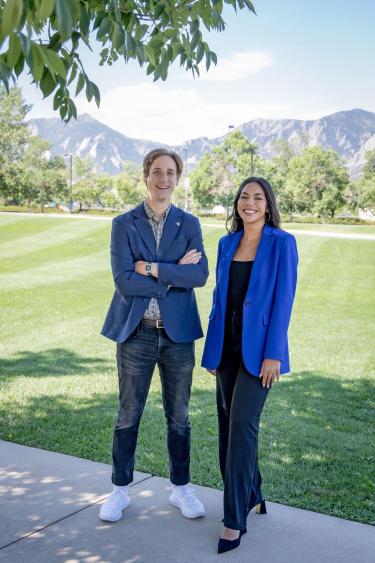
Principals
Johnny Hergert; Camila Uzcategui

Funding
CU Boulder New Venture Challenge (NVC) and Lab Venture Challenge (LVC); Buff Venture Fund; Caruso Ventures; Colorado Office of Economic Development and International Trade (OEDIT); Deming Center Venture Fund; Rockies Venture Club

Collaboration + support
College of Engineering and Applied Science; the McLeod Lab; Venture Partners at CU Boulder
Learn more about this topic:
 Researchers building a budding life sciences startup leverage venture development programming to achieve a major funding milestone
Researchers building a budding life sciences startup leverage venture development programming to achieve a major funding milestone
Vitro3D, a CU Boulder startup pioneering volumetric 3D printing for life sciences, closed its first investment round of $1.3 million in late 2022. The vote of confidence from the investment community will allow the promising new venture—and founders Camila Uzcategui (CEO) and Johnny Hergert (CTO)—to pursue ambitious technical advances while continuing to build critical business capacity.
Uzcategui and Hergert started Vitro3D together when they were PhD students in Professor Bob McLeod’s lab in CU Boulder’s College of Engineering and Applied Science. They often sat together in class, collaborated on papers and explored innovations with 3D printing. In late 2019, they jointly disclosed their first invention, “Orthogonal 3D control of properties in 3D printed structures,” to Venture Partners at CU Boulder, CU Boulder’s commercialization arm.
Uzcategui and Hergert saw the potential to print larger and more detailed parts, achieve faster speeds, and reduce cost and waste in 3D printing applications.
The company has licensed a portfolio of intellectual property from CU Boulder, based on foundational work developing a novel volumetric 3D printing technology. The approach has potential applications in the dental, medical and drug development industries.
At first, Vitro3D explored using the technology to regenerate growth plate tissue for children with growth-threatening long bone injuries by printing structures that could be infilled with cells and hydrogels to recreate cartilage. Through several exploratory Venture Partners programs, it became clear that the marketplace could benefit from their approach, but regulatory hurdles and other market characteristics would prevent the technology from reaching patients for decades.

A complex shape demonstrating Vitro3D’s novel volumetric 3D printing potential.
“We were realizing we had a technology platform that could do many things,” said Uzcategui. “The technology development for our original vision could still take place, but we wanted to find a different initial market that would allow us to create our impact faster.”
Uzcategui and Hergert dove into market research through Venture Partners’ Research-to-Market (R2M) and Starting Blocks programs, both part of CU Boulder’s I-Corps™ West Hub. After conducting more than 150 customer discovery interviews, they were confident they had found their initial market: dental aligners.
Once the company identified the dental market, progress accelerated quickly. Vitro3D gained visibility and accolades in the campuswide Lab Venture Challenge (LVC), drew notice from investors at the CU Boulder-hosted Destination Startup® showcase, and finished as runners-up in the New Venture Challenge (NVC). Along the way, the company secured nearly $450,000 in “non-dilutive” grants—including $250,000 from the Colorado Office of Economic Development and International Trade (OEDIT)—allowing them to transition off campus by the summer of 2022.
The company has already produced the fastest, largest part ever printed using the volumetric 3D method, but they are just getting started. The funding they’ve secured has allowed them to hire a senior engineer working to advance the printer’s hardware, algorithms and materials to continuously improve the size, speed and quality of printed parts.
With an eye on three distinct markets—first the dental market, then 3D cell culture for drug development and scaffolds for human organ and tissue regeneration—Vitro3D is now equipped to meet the technical goals and grow the business infrastructure needed to make the kind of difference Uzcategui and Hergert always envisioned.
Photos: Dental aligner prototype (top); founders Hergert and Uzcategui. Photos by: Ralena Gordon.
